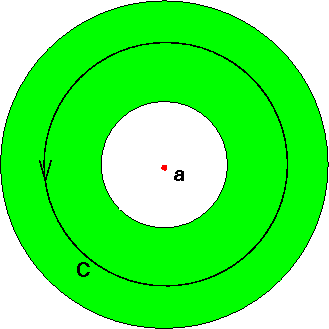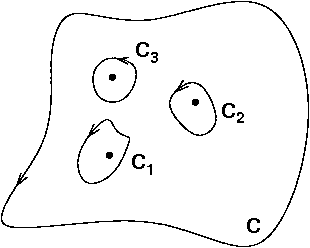Taylor and Laurent Series
- If a function $f(z)$ is analytic within a circle radius $R$
centred on $a$, then according to Taylor's theorem we can
write $f(z)$ as a power series
$$f(z)=f(a)+f'(a)(z-a)+f''(a)(z-a)^2/2!+\ldots+f^{(n)}(a)(z-a)^n/n!+\ldots.$$
- The radius of convergence, $R$, will be set by the position of
the singularity (e.g. a pole or branch point) that is closest to
$a$.
- If in a Taylor series the coefficients of the first $n$ terms
vanish, $f(z)$ has a zero of order $n$ at $z=a$.
 If a function $f(z)$ is analytic within an annulus of
inner radius $R_1$ and outer radius $R_2$ centred on $a$, then
according to Laurent's theorem we can write $f(z)$ as follows:
$$f(z) = \sum_{n=0}^\infty a_n(z-a)^n +
\sum_{n=1}^\infty\frac{b_n}{(z-a)^n},$$ where, taking the path
of integration to lie in the annulus (and encircling $a$),
$$a_n=\frac{1}{2\pi i}\oint \frac{f(z)}{(z-a)^{n+1}}\d
z\qquad\text{and}\qquad b_n=\frac{1}{2\pi i}\oint\;
f(z)(z-a)^{n-1}\d z.$$ The first series is called the regular
(or analytic) part of $f(z)$ and the second the principal
part.
If a function $f(z)$ is analytic within an annulus of
inner radius $R_1$ and outer radius $R_2$ centred on $a$, then
according to Laurent's theorem we can write $f(z)$ as follows:
$$f(z) = \sum_{n=0}^\infty a_n(z-a)^n +
\sum_{n=1}^\infty\frac{b_n}{(z-a)^n},$$ where, taking the path
of integration to lie in the annulus (and encircling $a$),
$$a_n=\frac{1}{2\pi i}\oint \frac{f(z)}{(z-a)^{n+1}}\d
z\qquad\text{and}\qquad b_n=\frac{1}{2\pi i}\oint\;
f(z)(z-a)^{n-1}\d z.$$ The first series is called the regular
(or analytic) part of $f(z)$ and the second the principal
part.
- If $b_m=0$ for all $m$, the series is just the Taylor series;
however, this will be true only if $f(z)$ is in fact analytic
inside the inner radius of the annulus.
- If $z=a$ is an isolated singularity (so not a branch point) of
$f(z)$, we can form a Laurent series about $z=a$ which is
valid for $0 < |z-a| < R$ where $R$ is the distance to the
next singularity. If the principal part terminates, so that
$b_m=0$ for all $m > n$, we say $f(z)$ has a pole of order $n$
at $z=a$. If $n=1$ we call it a simple pole. If there is no
such value $n$, $z=a$ is an essential singularity. $e^{1/z}$
is an example of a function with an essential singularity at
$z=0$.
- An entire function is analytic everywhere in the
finite complex plane; its Taylor series about any point $z=a$
has infinite radius of convergence. $e^z$ is an example of an
entire function.
- A meromorphic function is one that is analytic (in a
given region of the complex plane), except for a set of
isolated points that are poles of the function. $1/\sin z$ is
an example of a meromorphic function: it has simple poles at
$z=n\pi$ on the real axis.
- Define $w=1/z$ and $g(w)=f(1/w)$. Then the nature of any
singularity of $g$ at $w=0$ is the nature of any singularity
of $f$ at infinity. For example, $f(z)=z$ has a simple pole
at infinity, because $f(1/w)=1/w$ has a simple pole at $w=0$.
Similarly, $e^z$ has an essential singularity at
infinity.
Spiegel 6.1-5, (6.6), 6.7-12
Riley (18.4, 18.6), 18.13; Boas 14.4, 14.8; Arfken 6.5, 7.1


 If a function $f(z)$ is analytic within an annulus of
inner radius $R_1$ and outer radius $R_2$ centred on $a$, then
according to Laurent's theorem we can write $f(z)$ as follows:
$$f(z) = \sum_{n=0}^\infty a_n(z-a)^n +
\sum_{n=1}^\infty\frac{b_n}{(z-a)^n},$$ where, taking the path
of integration to lie in the annulus (and encircling $a$),
$$a_n=\frac{1}{2\pi i}\oint \frac{f(z)}{(z-a)^{n+1}}\d
z\qquad\text{and}\qquad b_n=\frac{1}{2\pi i}\oint\;
f(z)(z-a)^{n-1}\d z.$$ The first series is called the regular
(or analytic) part of $f(z)$ and the second the principal
part.
If a function $f(z)$ is analytic within an annulus of
inner radius $R_1$ and outer radius $R_2$ centred on $a$, then
according to Laurent's theorem we can write $f(z)$ as follows:
$$f(z) = \sum_{n=0}^\infty a_n(z-a)^n +
\sum_{n=1}^\infty\frac{b_n}{(z-a)^n},$$ where, taking the path
of integration to lie in the annulus (and encircling $a$),
$$a_n=\frac{1}{2\pi i}\oint \frac{f(z)}{(z-a)^{n+1}}\d
z\qquad\text{and}\qquad b_n=\frac{1}{2\pi i}\oint\;
f(z)(z-a)^{n-1}\d z.$$ The first series is called the regular
(or analytic) part of $f(z)$ and the second the principal
part.